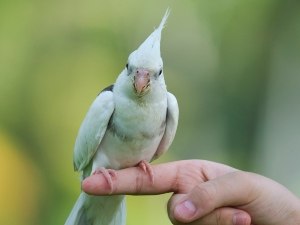
Changes are normal in your bird but its good to know why these changes are happening. This article looks into why your cockatiel is developing black spots on its beak.
Table of Contents
Black spots on cockatiel beak:
A beak to a bird is what teeth are to mammals, somewhat.
Your bird’s beak is used to grab and tear food and is needed by the bird for survival, so it needs to stay in tip-top shape.
Keeping an eye on your bird’s beak is a must and if you’ve been doing that and you find one or a few black spots on your bird’s beak you’re likely very worried.
Here are possible reasons why black spots have developed on your cockatiels beak:
It’s food:
The black spots on your cockatiel’s beak may simply be food debris stuck on the bird’s beak.
All birds will happily and hungrily eat food, birds usually wipe food off of their mouths after eating but this doesn’t always happen.
Your bird may have left some black-colored food on its beak and this may be what you are seeing.
What to do:
Check to see if this mysterious black material on your bird’s beak is food, gently wipe the bird’s beak using a damp cloth to test if this is food.
Do this gently as the black spots may actually be a bruise, if you press too hard this will be very painful for your bird.
Wear and tear:
These dark spots on your bird’s beak may be the result of everyday wear and tear. Some birds like to rub their beaks on things in their environment like cage bars or their perches
This isn’t an issue if it is done on occasion but if it is overdone then the bird can develop dark patches or black spots on its beak
What to do:
Birds don’t usually rub their beaks to the point of blackening their beak, there may be an underlying issue if your bird is doing this.
You may want to take your bird to the vet for an assessment if your bird is doing this.
It’s a bruise:
Bruises not only affect humans they affect birds too, including bird beaks. Bird beaks are made up of bones, connective tissue, capillaries, and a keratin layer on top.
If your bird suffers an injury then the blood vessels under the keratin layer may break and leak some blood creating a pool of blood or many small pools of blood.
These blood pools will darken and look black and these may be the black spots that you’re seeing.
What to do:
These types of injuries are usually mild and will heal themselves over time. You don’t have to worry as long as the bird is using its beak as normal.
If the bird is in distress and can’t eat then take it to the vet who will prescribe pain medications for the bird
Liver disease:
Another reason why your bird may have black spots on its beak may be that the bird has fatty liver disease.
This disease develops in birds who mostly eat a seed-based diet and it causes the liver to accumulate fat it also causes blood clots to develop in the bird.
These blood clots may develop in the bird’s beak as well. This may be what you’re seeing as black spots.
What to do:
A trip to the vet is recommended in this case, the vet may inject your bird if your bird is suffering from this condition and the vet may also recommend a change in your bird’s diet.
If you enjoyed this article then you may also be interested in other bird related articles. Here are some articles that you may be interested in: Brown Spot On Budgies Beak, Red Spot On Budgies Beak, Black Spot On Parakeets Beak, Stripes On Cockatiel Beak, Why Is My Ringnecks Beak Black?

